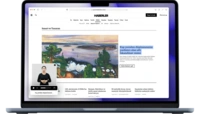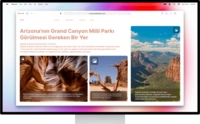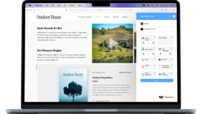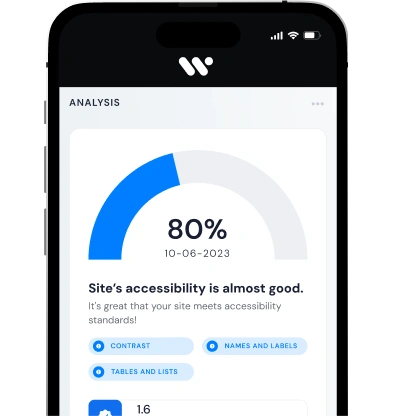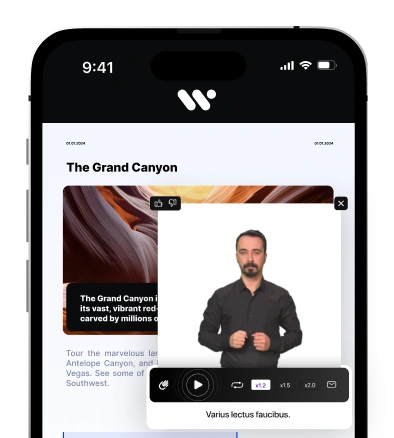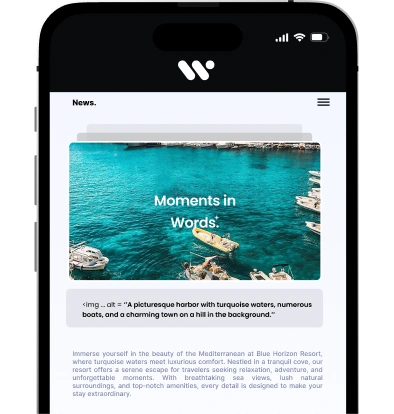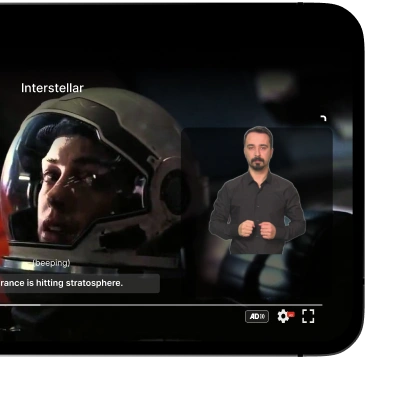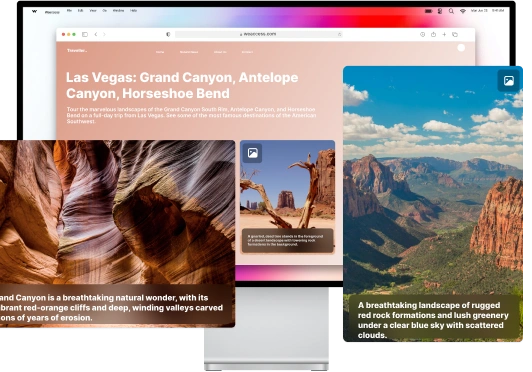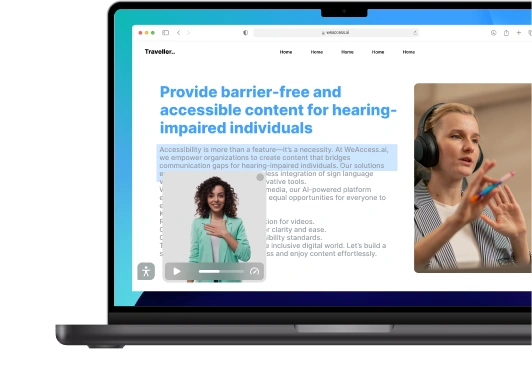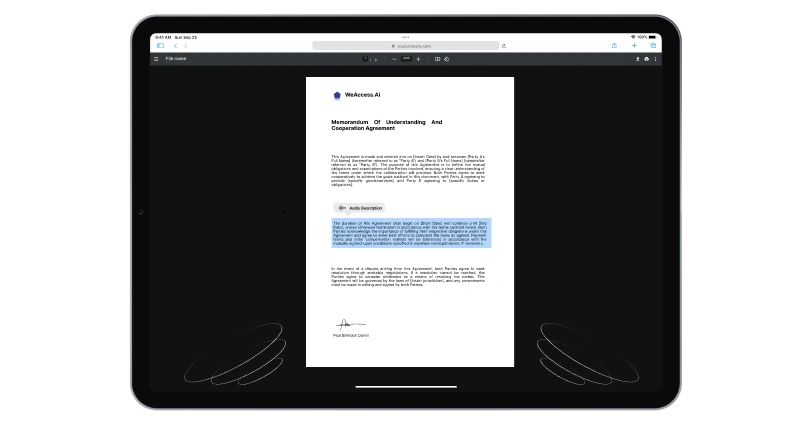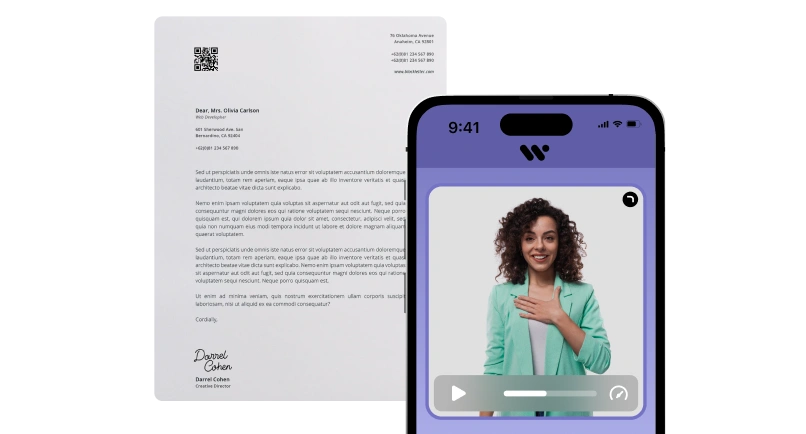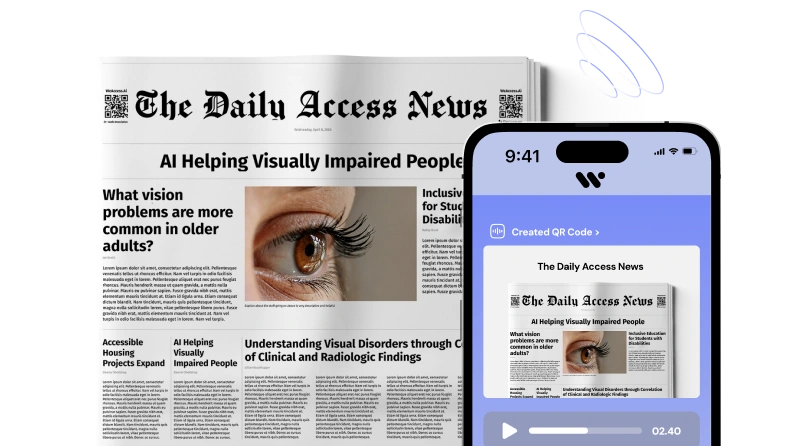Understanding Accessibility
Accessibility ensures that people with disabilities can navigate and interact with both physical and digital environments without barriers. Recognized as a fundamental human right, the rights of persons with disabilities emphasize equal opportunities in education, employment, and public life. Implementing universal design principles and adhering to guidelines like the Web Content Accessibility Guidelines (WCAG) are essential to guarantee ease of use for all. By prioritizing inclusive designs, society ensures that every individual, regardless of their disability, is afforded the opportunity to participate fully and independently
What is Accessibility?
Accessibility refers to designing environments, products, and services to be usable by all individuals, including those with disabilities. An accessible space ensures that everyone can navigate and interact without barriers. Improving accessibility involves implementing features like ramps, tactile indicators, and assistive technologies, enhancing the ease of accessibility for all users. Adhering to accessibility requirements, such as those outlined in the Americans with Disabilities Act (ADA), is essential for inclusive design. Incorporating accessibility features for disabled individuals, such as screen readers and voice recognition software, significantly increases accessibility and promotes equal participation.
Why Accessibility Matters
Accessibility is fundamental in ensuring equal access to opportunities and resources for all individuals, regardless of ability. An inclusive and accessible society upholds disability rights, enabling full participation in public life. This inclusivity benefits not only those with disabilities but also people without disabilities, fostering diverse and innovative communities. Prioritizing accessibility ensures that everyone can contribute meaningfully, reflecting a commitment to equality and human rights.
Legal Framework and Accessibility Standards
Ensuring accessibility for individuals with disabilities is reinforced by comprehensive legal frameworks and standards.
Americans with Disabilities Act (ADA):
Enacted in 1990, the ADA prohibits discrimination based on disability. Title II of the ADA mandates that state and local governments provide accessible services, programs, and activities. The Department of Justice oversees compliance, ensuring that public entities meet accessibility requirements.
Accessibility for Ontarians with Disabilities Act (AODA):
Established in 2005, the AODA aims to make Ontario fully accessible by 2025. It sets forth accessibility guidelines across various sectors, including customer service, transportation, and information technology, to promote inclusivity.
Web Content Accessibility Guidelines (WCAG):
The WCAG, developed by the World Wide Web Consortium (W3C), provides a global standard for web accessibility. These guidelines ensure that online content is perceivable, operable, understandable, and robust, aligning with the pillars of accessibility
The Americans with Disabilities Act (ADA)
The Americans with Disabilities Act (ADA), enacted in 1990, is a pivotal law that prohibits discrimination against individuals with disabilities, ensuring they have equal opportunities in various aspects of public life.
Key Provisions:
- Title II – Public Entities: This section mandates that state and local governments provide accessible services, programs, and activities. It requires that public spaces must be accessible to individuals with disabilities, ensuring they can participate fully in civic life
- Title III – Public Accommodations: This title obligates private businesses that serve the public to eliminate barriers, ensuring that facilities are accessible to all patrons. It addresses modifications to existing structures and the removal of architectural barriers
Impact on Public Spaces:
The ADA's emphasis on accessibility has led to significant changes in public infrastructure, including:
- Installation of ramps and elevators in public buildings.
- Modification of restrooms to accommodate wheelchair users.
- Provision of accessible parking spaces.
Combating Disability Discrimination:
By enforcing these standards, the ADA aims to eliminate discrimination against people with disabilities, promoting an inclusive society where all individuals have equal access to public spaces and services.
For more detailed information, you can refer to the official ADA guidelines provided by the U.S. Department of Justice.
Web Accessibility Standards
Web accessibility involves designing digital content to be usable by all individuals, including those with disabilities. Central to this effort are the Web Content Accessibility Guidelines (WCAG), developed by the World Wide Web Consortium (W3C). The latest version, WCAG 2.2, was published in October 2023, with WCAG 3.0 currently under development
Key Components of Web Accessibility:
- Digital Content Accessibility: Ensuring that text, images, videos, and other media are accessible to all users, including those using assistive technologies.
- Assistive Technologies: Tools like screen readers help users with visual impairments navigate and interact with digital content.
- Accessible Technology for Disabled Users: Implementing features such as keyboard navigability and alternative text for images to accommodate various disabilities.
By adhering to these standards, digital accessibility ensures that all users, regardless of ability, can access and engage with online information and services effectively.
Physical Accessibility
Physical accessibility ensures that individuals, regardless of ability, can navigate and utilize built environments without barriers. Achieving this involves addressing various aspects of design and infrastructure to accommodate all users.
Key Elements of Physical Accessibility:
- Building Accessibility for Disabled Individuals: Incorporating features such as ramps, elevators, and wide doorways to facilitate easy movement within buildings.
- Accessible Accommodations: Providing adaptable living spaces in residential facilities equipped with necessary support systems for residents with disabilities.
- Pedestrian Access: Designing sidewalks and pedestrian crossings to be easily navigable, ensuring safe and convenient movement for all.
- Accessibility Improvement: Regularly upgrading public spaces to remove obstacles and enhance usability for individuals with diverse abilities.
- Eliminating Barriers to Entry: Identifying and modifying physical obstructions that hinder access, promoting an inclusive environment for everyone.
Despite advancements, challenges persist. For instance, in Paris, wheelchair users face difficulties due to steep bus ramps and inadequate sidewalk conditions, highlighting the need for continued improvements
Building Accessibility Regulations
Ensuring that buildings are accessible to individuals with disabilities involves adherence to various regulations and standards designed to create inclusive environments.
Key Regulations:
- Architectural Barriers Act of 1968 (ABA): This act mandates that facilities designed, built, altered, or leased with federal funds be accessible to the public. It was among the first efforts to ensure federally funded buildings are accessible to people with disabilities
- Americans with Disabilities Act (ADA) of 1990: Under Title III, the ADA requires that all new construction and modifications after its enactment be fully compliant with accessibility guidelines. This includes ensuring that public accommodations are accessible to individuals with disabilities.
Building Codes and Standards:
- Uniform Federal Accessibility Standards (UFAS): Developed under the ABA, UFAS provides criteria for the design, construction, and alteration of buildings to ensure accessibility. These standards are applied to federally funded projects.
- ADA Accessibility Guidelines (ADAAG): Established under the ADA, ADAAG sets standards for accessible design, including specifications for accessible routes, entrances, and facilities within buildings
Design Considerations:
When creating accessible spaces, it's essential to consider both vertical and horizontal access. This includes:
- Entrances and Exits: Ensuring that all public entrances are accessible, with features like ramps and automatic doors.
- Interior Layout: Designing hallways, doorways, and common areas to accommodate mobility devices.
- Facilities: Providing accessible restrooms, elevators, and signage to assist navigation.
By adhering to these regulations and standards, we can ensure that new buildings and modifications to existing structures must be accessible, promoting inclusivity and equal access for all individuals, regardless of ability.
Web and Digital Accessibility
Web and digital accessibility ensure that all individuals, including those with disabilities, can perceive, understand, navigate, and interact with digital content and services. This encompasses websites, mobile applications, and other digital platforms.
Key Aspects:
- Web Content Accessibility Guidelines (WCAG): Developed by the World Wide Web Consortium (W3C), these guidelines provide a framework for making web content accessible. The latest version, WCAG 2.2, was published in October 2023, with WCAG 3.0 under development
- Assistive Technologies: Tools such as screen readers, magnifiers, and speech recognition software enable individuals with disabilities to interact effectively with digital content. However, challenges persist; for instance, blind and partially sighted users often find AI-driven tools inaccessible, limiting their benefits
- Accessible Design Practices: Incorporating features like alternative text for images, captions for videos, and keyboard navigability enhances usability for all users, particularly those with disabilities. Despite advancements, issues remain, such as the exclusion of blind users from AI technologies, highlighting the need for more inclusive design.
- Legal Requirements: Many regions have established laws mandating digital accessibility. For example, the European Union requires public sector websites and mobile applications to comply with WCAG standards, aiming to ensure accessibility for all citizens
- Ongoing Challenges: Despite progress, barriers persist. In Paris, efforts to enhance accessibility ahead of the 2024 Paralympics led to improvements in public transportation and signage. However, challenges remain, especially in older metro systems, underscoring the need for continuous enhancement
Common Web Accessibility Issues
Ensuring digital content is accessible to all users, including those with disabilities, is essential for an inclusive online experience. However, several common issues hinder accessibility:
- Inaccessible Navigation: Complex or non-intuitive navigation structures can pose significant challenges for users with disabilities, making it difficult for them to locate desired information or services.
- Lack of Alternative Text: Images without descriptive alt text prevent users who are blind or visually impaired from understanding visual content, creating barriers to information access.
- Insufficient Color Contrast: Low contrast between text and background colors can make reading difficult for users with low vision or color blindness, impeding readability and comprehension.
- Non-Accessible Forms: Forms lacking proper labels, instructions, or error messages can be confusing for users with cognitive disabilities, leading to frustration and incomplete submissions.
- Incompatible Multimedia Content: Videos or audio without captions or transcripts exclude users who are deaf or hard of hearing, limiting their access to multimedia information.
Addressing these issues is crucial for creating an inclusive digital environment that accommodates the diverse needs of all users.
Improving Web Accessibility
Enhancing web accessibility ensures that all individuals, including those with disabilities, can effectively access and interact with digital content. Implementing the following strategies can significantly improve accessibility:
- Adhere to Web Content Accessibility Guidelines (WCAG): Developed by the World Wide Web Consortium (W3C), WCAG provides comprehensive guidelines for making web content accessible. Following these standards helps in creating content that is perceivable, operable, understandable, and robust for all users
- Utilize Assistive Technologies: Incorporate tools such as screen readers, magnifiers, and speech recognition software to support users with various disabilities. These technologies facilitate interaction with web content, ensuring that users can acquire information effectively.
- Design with Accessibility in Mind: Ensure that your website is compatible with assistive technologies. This includes providing alternative text for images, captions for videos, and ensuring compatibility with screen readers. Such measures allow users with disabilities to access the same information as others.
- Conduct Regular Accessibility Audits: Utilize tools like WebAIM's WAVE to evaluate your website's accessibility. Regular assessments help identify and address potential barriers, ensuring continuous improvement in accessibility
- Engage with the Community: Participate in forums and discussions focused on web accessibility to stay informed about best practices and emerging challenges. Collaborating with others can provide valuable insights and support in making your website more accessible.
Implementing these practices not only complies with legal requirements but also fosters an inclusive digital environment where all users can navigate and interact with web content seamlessly.
Assistive Technologies
Assistive technologies are devices or systems designed to support individuals with disabilities, enhancing their ability to perform tasks that might otherwise be challenging. These technologies span various categories, addressing diverse needs:
- Communication Aids: Tools such as Blissymbols boards and electronic speech synthesizers assist individuals with speech impairments in expressing themselves effectively
- Hearing Support: Devices including hearing aids, cochlear implants, and real-time closed captioning systems help those with hearing impairments perceive sounds and engage in conversations.
- Mobility Assistance: Wheelchairs, voice-operated mobility devices, and adaptive keyboards enable users with mobility impairments to navigate their environments and interact with technology more effectively.
- Visual Aids: Screen readers, magnification software, Braille displays, and optical scanners assist individuals with visual impairments in accessing digital content and navigating the web.
- Cognitive Support: Tools like talking textbooks and virtual keyboards aid users with learning disabilities or cognitive impairments in processing information and interacting with digital content.
Tools and Devices
Assistive technologies encompass a broad spectrum of tools and devices designed to enhance the daily lives of individuals with disabilities. Notable examples include:
- Wheelchairs: Manual or powered chairs that facilitate mobility for individuals with mobility impairments.
- Screen Readers: Software applications that convert digital text into synthesized speech, aiding those who are blind or visually impaired in accessing digital content
- Hearing Aids: Devices that amplify sound for individuals with hearing impairments, improving their ability to perceive audio stimuli
- Braille Displays: Devices that translate digital text into Braille, allowing tactile reading for users who are blind
- Adaptive Keyboards and Mice: Input devices customized to accommodate various physical impairments, facilitating easier interaction with computers.
- Voice Recognition Software: Programs that enable users to control devices and input text using voice commands, beneficial for individuals with mobility or dexterity challenges.
- Augmented Reality (AR) Applications: Tools like Augmenta11y utilize AR to assist users with dyslexia in reading by overlaying customized text enhancements in real-time
- Brain-Computer Interfaces (BCIs): Advanced systems that translate neural activity into digital commands, enabling users with severe mobility impairments to interact with technology using thought alone.
Overcoming Accessibility Challenges
Addressing accessibility challenges for individuals with disabilities necessitates a multifaceted approach that combines policy development, technological innovation, and community engagement. Key strategies include:
- Implement Inclusive Design Practices: Incorporating universal design principles ensures that products, services, and environments are accessible to all, regardless of ability. This approach not only benefits individuals with disabilities but also enhances usability for the broader population.
- Promote Assistive Technology Integration: Leveraging assistive technologies, such as screen readers, adaptive controllers, and hearing aids, empowers individuals with disabilities to engage more fully with digital content and physical spaces. Organizations like AbleGamers exemplify this by providing customized solutions and support to gamers with disabilities.
- Enforce and Enhance Legal Frameworks: Strengthening legislation like the Americans with Disabilities Act (ADA) and the Disability Discrimination Act is crucial in mandating accessibility standards across public and private sectors. These laws serve as a foundation for advocating equal rights and opportunities for individuals with disabilities.
- Foster Community and Professional Collaboration: Engaging with organizations dedicated to disability advocacy and support facilitates knowledge exchange and the development of best practices. For instance, initiatives led by professionals like Ada Lopez at Lenovo aim to reduce biases in technology and promote inclusivity
- Invest in Accessible Infrastructure: Developing physical environments that accommodate all individuals is essential. Projects like the Kelsey Civic Center in San Francisco demonstrate how inclusive housing can be both accessible and community-oriented, offering adaptable living spaces and proximity to essential services
Common Accessibility Problems
Individuals with disabilities often encounter a range of barriers that hinder their full participation in society. Key challenges include:
- Physical Barriers: Inaccessible public spaces, transportation systems, and buildings pose significant obstacles. For instance, wheelchair users frequently face difficulties due to inadequate infrastructure, such as steep bus slopes and insufficient elevator sizes
- Digital Divide: Limited access to technology and the internet exacerbates social exclusion for people with disabilities. In 2011, only 54% of households with a person who had a disability had home internet access, compared to 81% of households without
- Transportation Challenges: Disabled individuals often experience discrimination and inadequate support in public transportation systems. Issues include unavailable ramps, differing rules on mobility scooters between rail companies, and inaccessible public transport, leading to exclusion and anxiety
- Product and Service Accessibility: Many products and services fail to accommodate disabled users, leading to feelings of exclusion. A survey revealed that two-thirds of adults with disabilities feel disregarded by retailers due to accessibility issues in product and store designs
- Discriminatory Practices: Instances of discrimination against people with disabilities persist, including in rideshare services where users face ride cancellations, charges for guide dogs, and outright refusals. Advocates call for better driver education on ADA compliance and stricter anti-discrimination measures
Solutions for Accessibility
Addressing accessibility challenges requires a comprehensive approach that includes policy reforms, technological innovations, and community engagement. Key solutions include:
- Inclusive Education: Implementing specialized programs and support services ensures that students with disabilities receive quality education tailored to their needs. This includes accessible learning materials, assistive technologies, and trained educators
- Assistive Technologies: Leveraging tools such as screen readers, adaptive keyboards, and AI-driven applications enhances digital accessibility for individuals with disabilities. For example, Microsoft's Copilot AI assistant provides real-time captions and message filtering, supporting neurodivergent employees
- Accessible Infrastructure: Ensuring that public and private spaces are designed or modified to accommodate individuals with mobility impairments is crucial. This involves adhering to building codes that mandate features like ramps, elevators, and wide doorways
- Employment Inclusivity: Promoting workplace diversity by implementing policies that support the hiring and retention of employees with disabilities benefits organizations economically and socially. Studies have shown that inclusive workplaces lead to increased productivity and innovation.
- Community Engagement: Collaborating with organizations dedicated to disability rights, such as the Zero Project, fosters the sharing of innovative solutions and best practices. This global initiative researches and disseminates strategies to remove barriers for individuals with disabilities.
You may be interested in: Spains Digital Accessibility Compliance, Polands Digital Accessibility Standards, Assistive Tech in Digital Accessibility


